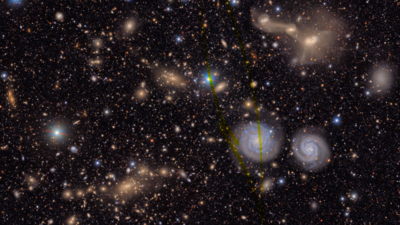
Vera Rubin Observatory captures distant galaxies (Image: X/@VRubinObs)
After over 20 years in the making, the Vera C Rubin Observatory in Chile released its first images on Monday, revealing stunning views of the universe and highlighting its powerful abilities.The observatory is located on Cerro Pachón in the Chilean Andes. It works in clear, dark skies and dry weather, making it ideal for capturing even the faintest details in space.
Early images reveal cosmic wonders
One of the first images is a combination of 678 photos taken in just seven hours, showing stunning star-forming areas like the Trifid and Lagoon Nebulas.
These vibrant clouds of gas and dust, located 9,000 light-years from Earth, appear in vivid pink, red and orange hues, revealing features never before seen in such clarity.Another image reveals the expansive Virgo Cluster of galaxies, offering a glimpse into the large-scale structure of the cosmos.
The observatory is set to dramatically expand our understanding of the solar system. In just its first few hours of operation, it has already identified more than 2,100 previously unknown asteroids, including several near-Earth objects.Scientists believe that if a theoretical ninth planet exists beyond Neptune, the Rubin Observatory can detect it within its first year. Its advanced tracking of potentially dangerous asteroids and high-resolution mapping of the Milky Way will play a crucial role in both planetary defence and deep-space research.
A new era in astronomy
Equipped with an advanced 8.4 metre telescope and housing the largest digital camera ever constructed, the Rubin Observatory represents a major leap forward in astronomical observation. Its state-of-the-art data processing system will allow scientists to scan the southern night sky continuously for the next decade as part of the
Legacy Survey of Space and Time
(LSST). This ambitious project aims to detect subtle changes across billions of stars and galaxies, helping researchers unravel the universe’s history.A central goal of the observatory is to shed light on
dark matter
and dark energy—two elusive components that are believed to make up about 95 percent of the universe. Despite their vast influence on the cosmos, their true nature remains one of the biggest mysteries in modern science.Named after Vera Rubin, the astronomer whose work first confirmed the existence of dark matter, the facility will provide crucial data to probe these cosmic mysteries.Professor Catherine Heymans, the astronomer royal for Scotland, emphasized the significance of this moment, noting that she has dedicated 25 years toward realizing the observatory’s potential. The UK plays a vital role in this global effort, hosting data centres that will manage and analyse the massive volumes of detailed images captured nightly.Michael Kratsios, director of the White House office of science and technology policy, called the Rubin Observatory "an investment in our future."

 8 hours ago
52
8 hours ago
52




























 English (US)
English (US)